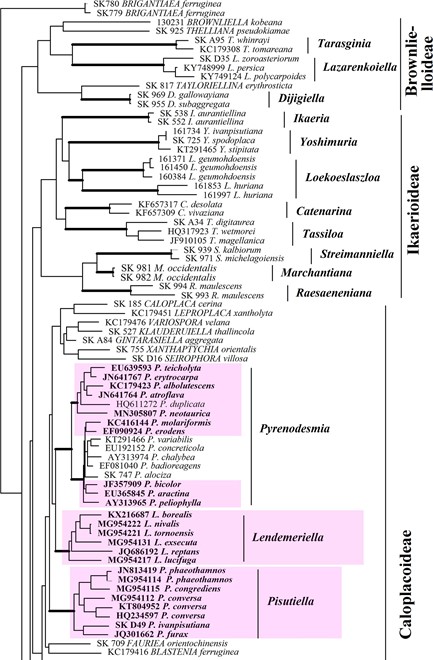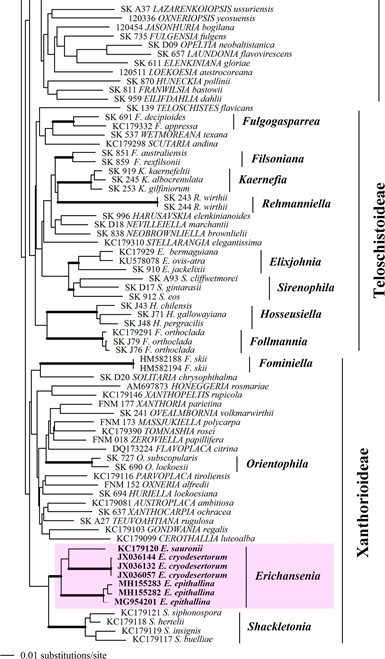Pisutiella S. Y. Kondr., L. Lőkös et E. Farkas, gen. nov.
MycoBank number: MB 834212; Index Fungorum number: IF 834212; Facesoffungi number: FoF
Similar to Usnochroma, but differs in having mostly badly developed or li- chenicolous thallus, as well as in the lack of usnic acid.
Type species: Pisutiella conversa (Kremp.) S. Y. Kondr., L. Lőkös et E. Farkas.
Thallus crustose, from well developed, areolated, grey to light grey or brownish grey or blackish grey on rock surface or well distinct as orbicular portions on host lichen thalli, to consisting of a few brown to deep brown- ish grey areoles, or entirely reduced; mostly lichenicolous. Thallus if well developed (P. furax) is thick with well developed cortical layer. Vegetative diaspores are absent.
Apothecia lecanorine or zeorine, with thalline margin concolorous with thallus (sometimes disappearing with time), and dull brownish, brownish yellow or dull brownish-reddish to blackish-brownish, and ochre-brown, dull or bright reddish brown or rusty brown to blackish brown disc, or biatorine with yellow-orange rather thick own margin, immersed or semi-immersed in the thallus. Epihymenium dull yellowish. Asci clavate, Teloschistes type, with eight spores. Ascospores polardiblastic, ellipsoid, sometimes distinctly swol- len at the septum and rather short. Conidiomata of Xanthoria type, conidia widely fusiform or slightly pyriform.
Chemistry: Thallus K– or rarely cortical layer K+ lightly pink, C–; disc of apothecia K+ red; epihymenium K+ purple. Anthraquinone content in apothe- cial disc often was not investigated, while parietin, emodin and fallacinal was previously recorded for some species.
Ecology: Growing on isolated boulders of base rich or lime-containing si- liceous rocks, more rarely on compact limestone and dolomite, on bryophytes or lichenicolous (on thalli and apothecia of Aspicilia epiglypta (Norrl. ex Nyl.) Hue or other Aspicilia spp. and Candelariella vitellina (Hoffm.) Müll. Arg., C. coralliza (Nyl.) H. Magn. and other crustose lichens); at altitudes 600–2,200 m in all ecological classes, except for humid non-alpine habitats.
Etymology: It is named after the well-known Slovak lichenologist Ivan Pišút (1935–2017) to acknowledge his great contribution to our knowledge on lichens of the Carpathians and in recognition of his general contribution to lichenology.
Distribution and species diversity: Distributed in various plant commu- nities and ecosystems of all continents of the northern hemisphere. The genus is hitherto including 6 species (Pisutiella congrediens, P. conversa, P. furax, P. grimmiae, P. ivanpisutii, and P. phaeothamnos).
Taxonomic notes and phylogenetic affiliations: The genus Pisutiella is similar to Usnochroma Søchting, Arup et Frödén, but differs in having mostly badly developed or a lichenicolous thallus, as well as in the lack of usnic acid. The genus Pisutiella is similar to Blastenia in having somewhat ochra- ceous brown apothecia, but differs in having a different ecology and distribu- tion, as well as positioning in separate branch of the phylogenetic tree of the Teloschistaceae.
The genus Pisutiella is similar to Pyrenodesmia in having ochraceous brown apothecia, but differs in having another ecology and distribution, as well as positioning in separate branch of the phylogenetic tree of the Teloschistaceae. In numerous phylogenetic trees of the Teloschistaceae with varying number of vouchers and species included the genus Pisutiella is positioned as a strong branch between Rufoplaca and Usnochroma of the Pyrenodesmia s. l.
subclade of the Caloplacoideae.
Three species of this genus, i.e. Pisutiella congrediens, P. grimmiae, and P. phaeothamnos were included in the Sect. Coccinodiscus of the genus Caloplaca by Poelt et Kalb (1985).
During one period Pisutiella furax was included in ‘Caloplaca’ conglome- rata (Nimis 1993: 162), but now accepted as a separate species differing in parasitic habit (see Nimis 2016).
The position of Pisutiella grimmiae within this genus is still waiting for confirmation by molecular data. However, Vondrák and colleagues (Vondrák et al. 2019) emphasised the close relation of the three species (i.e.: ‘Caloplaca’ congrediens, ‘Caloplaca’ grimmiae, and ‘Caloplaca’ phaeothamnos) supported by nrITS sequence data, while molecular data on Pisutiella grimmiae are so far missing in the GenBank.
The ‘Caloplaca’ teicholyta or ‘Caloplaca’ xerica group.
A status of the ‘Caloplaca’ teicholyta or ‘Caloplaca’ xerica group in the phy- logenetic tree of the Teloschistaceae was clarified, while analysis of the species diversity of this group, as well as other groups of the Pyrenodemia subclade were not the object for our present study.
As emphasised above, the new genera Erichansenia, Lendemeriella and Pisutiella, were strongly supported in the phylogenetic tree of the Teloschista- ceae, whereas the ‘Caloplaca’ teicholyta or ‘Caloplaca’ xerica group is positioned within the Pyrenodesmia branch (Fig. 1). The branch including Pyrenodesmia species, included in our study, is also strongly supported why we conclude that the former ‘Caloplaca’ teicholyta or ‘Caloplaca’ xerica group have to be in- cluded in the genus Pyrenodesmia. Of the sixteen species belonging to the Pyrenodesmia branch (Fig. 1), eight still needed new combinations, which are proposed below.

Fig. 1. Position of the genera Erichansenia, Lendemeriella and Pisutiella, as well as the ‘Calo- placa’ teicholyta or ‘Caloplaca’ xerica group in the combined phylogenetic tree of the Telo- schistaceae based on nrITS, nrLSU and mtSSU sequences

Fig. 1. (continued)
Species
